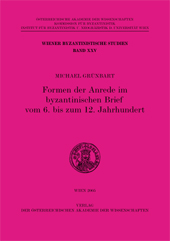In der vorliegenden Studie werden erstmalig die Anredeformen in der byzantinischen Epistologie vom sechsten bis zum zwölften Jahrhundert systematisch behandelt. Aus über 3600 Briefen von 100 Epistolographen wurden 5500 Anredeformen exzerpiert und in einem alphabetischen Katalogteil präsentiert, die als Basis für die Untersuchung dienten.
Direkte und indirekte Anredeformen bilden ein wichtiges formales Gestaltungselement eines byzantinischen Briefes. Die Wahl der Anredeformen kann auch Rückschlüsse auf das Verhältnis zwischen Adressaten und Adressanten geben. Stehen die Korrespondenten in einem engen freundschaftlichen oder in einem sachlichen, distanzierten Verhältnis?
Das Anredevokabular lässt sich drei Bereichen zuordnen: Teilweise gehen die Anredeformen auf die klassisch antike Literatur zurück (z.B. Homer, Plato), teilweise kommen sie aus dem biblischen (besonders Neues Testament) sowie dem byzantinischen Sprachgebrauch (z.B. Titel, Epitheta).
Obwohl es kaum zeitgenössische theoretische Hinweise auf die Verwendung von Anredeformen gibt, ermöglicht die Menge des Materials eine teilweise Rekonstruktion des Anredesystems. Es kann gezeigt werden, dass bestimmte Anredewörter für bestimmte gesellschaftliche Gruppen relevant bzw. reserviert waren (Anredeformen für den Kaiser und seine Familie, weltliche und geistliche Personen).
Gedruckt mit Unterstützung des Fonds zur Förderung der wissenschaftlichen Forschung (FWF).

…
This study is the first major systematic investigation on forms of address in sixth to twelfth century Byzantine epistology. It is based on more than 3600 letters written by 100 epistolographers, providing about 5500 forms of address which are listed in an alphabetical catalogue. Direct and indirect form of address constitute an essential part of the Byzantine letter and therefore they were chosen carefully by epistolographers. They indicate the relationship between sender and receiver. Do the two correspondents have an close friendship, or are they on more formal terms? The greetings used by letter-writers can be classified according to three different types: greetings based on classical literature (e.g. Homer, Plato), biblical allusions (especially from the letters of the New Testament) and Byzantine terms (especially titles).
Contemporary sources offer little information on forms of address, but the quantity of the collected material has allowed an analysis of the characteristics and tendencies of their usage to be made. It can be shown that certain forms of address were used by or reserved for particular social groups (the emperor and his family, clergy and secular persons).




